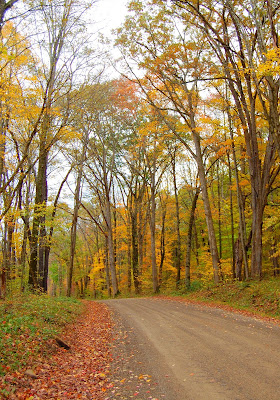Reflections - Predicting the Nasties?
 |
| Fall on West Creek Road |
My sister Anita inspired my early fall hunts. Years back, she had emailed from New Jersey. I haven’t seen any woolly bears this year. Have you?
Weary of shoveling snow and scraping ice, she turned to woolly bear caterpillars, famous for predicting the severity of winter.
Leaves turned golden-orange and red this September. On daily walks with Spence, I scanned the road for the caterpillar with fuzzy orange and black stripes, a natural for Halloween. This year the first woolly bear, a future Isabella tiger moth, crawled past on September 23. Woolly bear numbers increased to four a day, six a day, then more than a dozen.
Giddy as a youngster collecting Easter eggs, I kept my head bent. I didn’t count the all-black (the giant leopard moth) or the all orange-yellow (the yellow woolly bear of the Virginia tiger moth) caterpillars. They aren’t woolly bears. I also rejected smashed garter snakes. Stepping over the third one on a day in early October, I asked Spence, “Why are there so many dead snakes in the road?”
“They’re migrating.”
“You’re kidding.”
“No, they travel miles.” He shoved his hands into jeans pockets. “They hibernate underground in groups of hundreds.”
I preferred looking at the smashed snakes to the vision his answer gave me.
Three weeks into the woolly bear hunts, I suggested a variation. “Let’s play the cow game with woolly bears.” I hadn’t worked out the rules for multiplying the total, like a church marries the cows to double the herd, or killing the critters by passing a graveyard before Spence blurted, “Snakes kill them.”
 |
| Third Woolly Bear Caterpillar of the Year |
We spied four creeping woolly bears but smashed snakes did the caterpillars in. The dead snakes flattened more each day but didn’t disappear. I gave up on the woolly cow-bear game but not the hunt. As woolly bears found places to hibernate, their numbers dwindled to one every other day or so. One cute black and orange body undulating across the road begged to be petted. I stroked its fuzzy hairs with my finger causing the caterpillar to curl into a ball and Spence to admonish, “Don’t leave it there. Kathy will run over it. Put it on the side.”
I lifted the fuzzy ball, whispered “I’m sorry,” and placed it on a red maple leaf at the edge of the road. The caterpillar stayed curled and, like a pie chart, displayed one-third black at its head, a long orange middle, and a tiny black posterior. Nearly all woolly bears sported that same pattern this season. Unique. Most years the width of stripes varies from caterpillar to caterpillar. I emailed photos of four woolly bears for my sister’s analysis.
From the looks of your woolly bears, she wrote, I would say a nasty start to winter with a decent mild streak before the end week or two of more nasties . . . We will see once it starts.
I checked woolly bear predictions’ accuracy online.
Dr. C. H. Curran ran experiments in the early 1950s and calculated 80% accuracy. He gave up in 1955, however, because the woolly bears’ stripes varied too much. No one has been able to reproduce his research. Mike Peters, an entomologist, says the older the caterpillar, the more times it has shed skin, and the more brown hairs it grows. I trusted his research despite his sense of color—calling the stripe, which my quilter’s eye perceives as orange, brown.
I tested the entomologist’s theory.
Paging through my farm journals for last winter, I counted snow days and days with high temperatures below freezing. A pattern emerged. Snow and below-freezing temperatures dominated the middle five weeks of winter. The first four weeks had seven nasty days but scattered—not one after another. The last four weeks had only three wintry days.
This years’ crop of woolly bears recorded that pattern precisely. A longer black stripe by the head represented the cooler beginning of winter, the long stretch of orange indicated the mere five weeks of wintry weather, and the short black posterior recorded the mild end. The woolly bears also predicted the overall mildness of the winter. Every day the temperature rose at least to the low 20s F [-5° or -6 °C]. No arctic blasts.
Winter will come. I’ll track the weather and predict the pattern for next year’s woolly bears. But I can wait. I’m still enjoying fall.
Leaves, copper and crimson, glow.
Leaves, under squirrel feet, crunch.
Leaves, decomposing, perfume.





